The Hex Bar Dead Lift - A Quick OverviewA Quick Overview of The Hex Bar Dead LiftBy Bigger Faster Stronger Published: The Hex Bar Dead Lift is halfway between a Dead Lift and a Squat. It develops the lower back, trunk, hips, glutes, hamstrings and quadricep area. When you combine shrugs, the trapezius area is also strengthened. It is considered a Core Lift exercise to be done once per week. The unique shape of the Hex Bar makes it easier to maintain perfect form when performing the Dead Lift exercise. Image 1- Use a jump stance. Be tall and spread the chest to lock-in the lower back. Keep head up, hips down and elbows locked. Keep the knees over toes. Lift the bar straight up with the legs. Shown is the Hi-Hex Bar which helps taller athletes get into a safe starting position. Imags 2 -The bar should continue up in a straight line as legs are extended. Do not pull with arms. Always keep chin away from chest. When legs are completely straight and hips are forward, you may start back down keeping the head up, chest spread and lower back locked in. Image 3 - When doing reps, bounce the weight slightly off the floor. Do shoulder shrugs on the last rep of each set to build the traps (only a straight up and down movement is required with this bar--do not do revolving shoulder shrugs). Image 4 - Doing a regular Dead Lift with a spot is a safe alternative, especially on Max Lifts, when a Hex Bar is not available. The spotter places one hand on the lower back, places the crook of his elbow of the other arm in front of the lifter’s front shoulder and then pulls back and up to get bar into a center alignment. Image 5 - Straight Leg Dead Lifts are a top priority Auxiliary exercise. Advanced lifters use no more than 40% of your Parallel Squat Max. Beginners use 45 to 95 pounds. Think of this as a stretching exercise for speed improvement. Keep the knees locked. Go slow and controlled. |
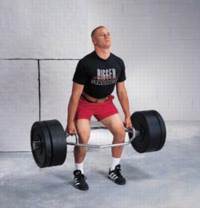 |
|
Image 1 |
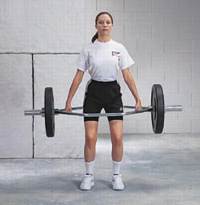 |
|
Image 2 |
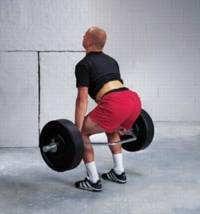 |
|
Image 3 |
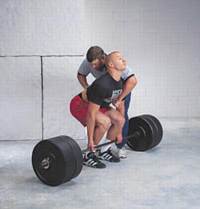 |
|
Image 4 |
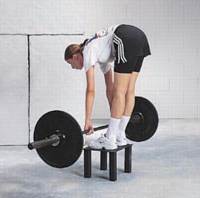 |
|
Image 5 |